technical data AUDI S8 2008 User Guide
[x] Cancel search | Manufacturer: AUDI, Model Year: 2008, Model line: S8, Model: AUDI S8 2008Pages: 404, PDF Size: 52.7 MB
Page 203 of 404
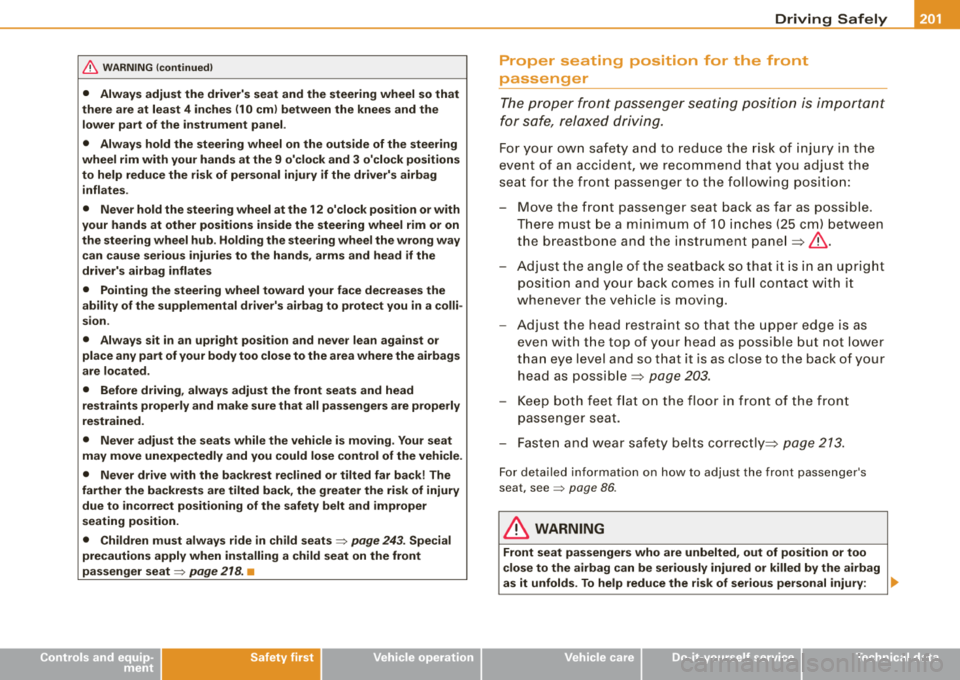
& WARNING (continued)
• Always adjust the driver's seat and the steering wheel so that
there are at least 4 inches (10 cm) between the knees and the
lower part of the instrument panel .
• Always hold the steering wheel on the outside of the steering
wheel rim with your hands at the 9 o'clock and 3 o'clock positions
to help reduce the risk of personal injury if the driver's airbag inflates .
• Never hold the steering wheel at the 12 o'clock position or with
your hands at other positions inside the steering wheel rim or on
the steering wheel hub. Holding the steering wheel the wrong way
can cause serious injuries to the hands, arms and head if the
driver's airbag inflates
• Pointing the steering wheel toward your face decreases the
ability of the supplemental driver's airbag to protect you in a colli
sion .
• Always sit in an upright position and never lean against or
place any part of your body too close to the area where the airbags
are located.
• Before driving, always adjust the front seats and head
restraints properly and make sure that all passengers are properly
restrained .
• Never adjust the seats while the vehicle is moving. Your seat
may move unexpectedly and you could lose control of the vehicle.
• Never drive with the backrest reclined or tilted far back! The
farther the backrests are tilted back, the greater the risk of injury due to incorrect positioning of the safety belt and improper
seating position.
• Children must always ride in child seats
=> page 243. Special
precautions apply when installing a child seat on the front
passenger seat
=> page 218 . •
Controls and equip
ment Safety first
Vehicle operation
Driving Safely
Proper seating position for the front
passenger
The proper front passenger seating position is important
for safe, relaxed driving.
For your own safety and to reduce the risk of injury in the
event of an accident, we recommend that you adjust the
seat for the front passenger to the follow ing position:
- Move the front passenger seat back as far as possible.
There must be a minimum of 10 inches (25 cm) between
the breastbone and the instrument
panel=> &.
-Adjust the angle of the seatback so that it is in an upright
position and your back comes in full contact with it
whenever the vehicle is moving.
- Adjust the head restraint so that the upper edge is as
even with the top of your head as possible but not lower
than eye level and so that it is as close to the back of your
head as
possible => page 203.
-Keep both feet flat on the floor in front of the front
passenger seat.
- Fasten and wear safety belts
correctly =:> page 213.
For detailed information on how to adjust the front passenger's
seat, see
=> page 86 .
& WARNING
Front seat passengers who are unbelted, out of position or too
close to the airbag can be seriously injured or killed by the airbag
as it unfolds. To help reduce the risk of serious personal injury : ..,_
Vehicle care Do-it-yourself service Technical data
Page 205 of 404
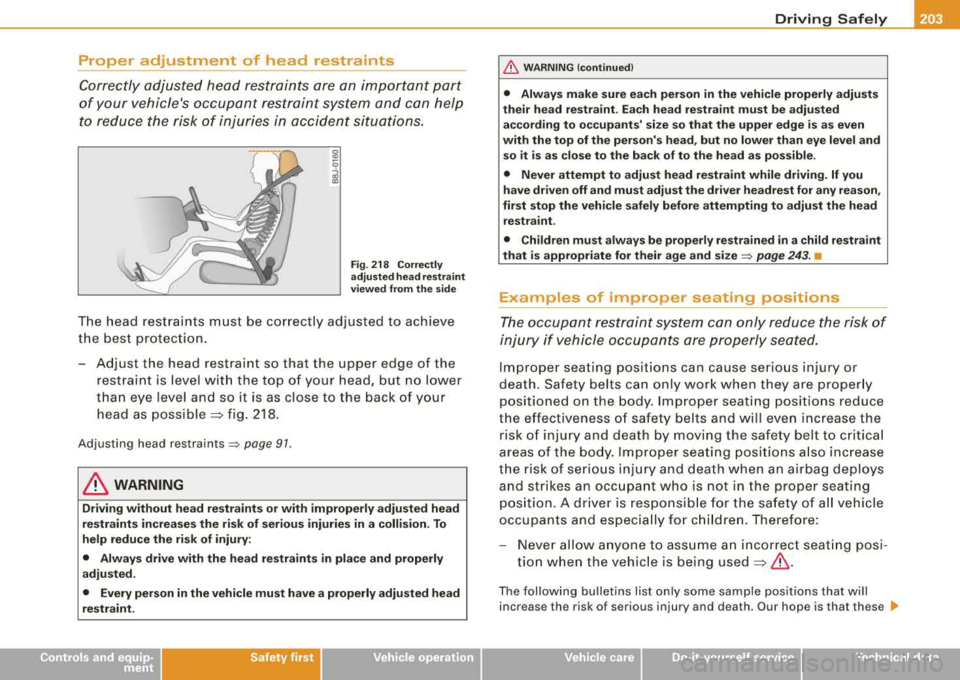
Driving Safely fflll
---------------------------------------------:::....---=--
Proper adjustment of head restraints
Correctly adjusted head restraints are an important part
of your vehicle's occupant restraint system and can help to reduce the risk of injuries in accident situations.
Fig . 218 Correctly
adjusted head restraint
viewed from the side
The head restraints must be correctly adjusted to achieve
the best protection.
- Adjust the head restraint so that the upper edge of the
restraint is level with the top of your head, but no lower
than eye level and so it is as close to the back of your
head as
possible ~ fig. 218.
Adjusting head restraints=> page 91.
& WARNING
Driving without head restraints or with improperly adjusted head
restraints increases the risk of serious injuries in a collision. To
help reduce the risk of injury:
• Always drive with the head restraints in place and properly
adjusted.
• Every person in the vehicle must have a properly adjusted head
restraint.
Controls and equip ment Safety first Vehicle operation
&, WARNING
(continued)
• Always make sure each person in the vehicle properly adjusts
their head restraint. Each head restraint must be adjusted according to occupants' size so that the upper edge is as even
with the top of the person's head, but no lower than eye level and
so it is as close to the back of to the head as possible .
• Never attempt to adjust head restraint while driving. If you
have driven off and must adjust the driver headrest for any reason,
first stop the vehicle safely before attempting to adjust the head
restraint.
• Children must always be properly restrained in a child restraint
that is appropriate for their age and size
=> page 243. •
Examples of improper seating positions
The occupant restraint system can only reduce the risk of
injury if vehicle occupants are properly seated.
Improper seating positions can cause serious injury or
death . Safety belts can only work when they are properly
positioned on the body. Improper seating positions reduce
the effectiveness of safety belts and will even increase the
risk of injury and death by moving the safety belt to critical
areas of the body. Improper seating positions also increase
the risk of serious injury and death when an airbag deploys
and strikes an occupant who is not in the proper seating
position. A driver is responsible for the safety of all vehicle
occupants and especially for children. Therefore:
- Never allow anyone to assume an incorrect seating posi
tion when the vehicle is being
used ~& .
The following bulletins list only some sample positions that will
increase the risk of serious injury and death. Our hope is that these
.,_
Vehicle care Do-it-yourself service Technical data
Page 207 of 404
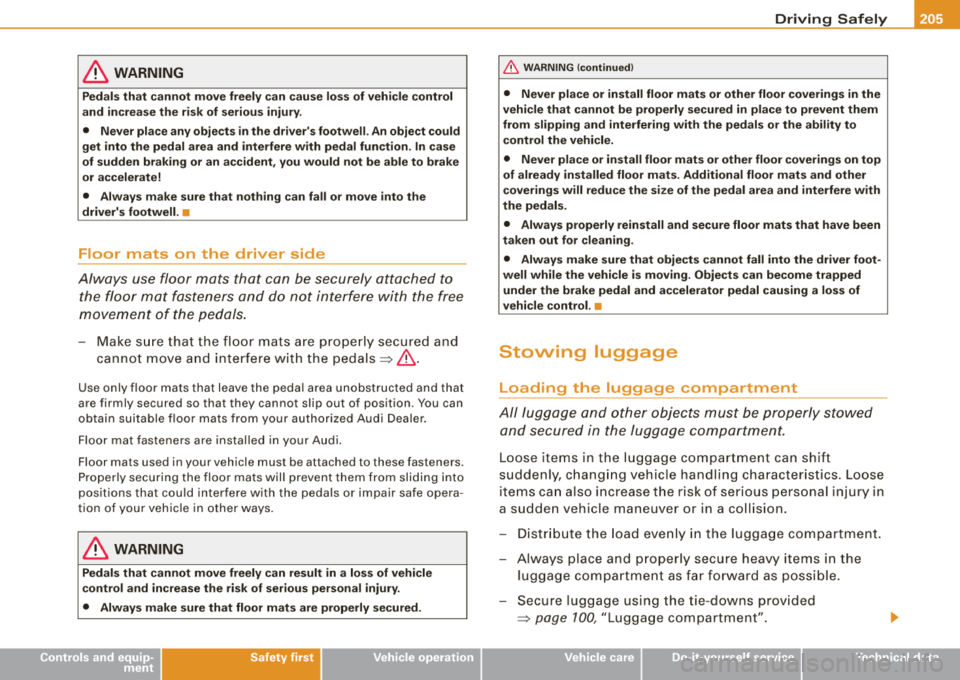
------------------------------------------------=D:.:.r.:.iv :..:.:. in.:.:g~ S::. a
::.:. fe::.:.! ly~ --
& WARNING
Pedals that cannot move freely can cause loss of vehicle control
and increase the risk of serious injury.
• Never place any objects in the driver's footwell . An object could
get into the pedal area and interfere with pedal function. In case
of sudden braking or an accident, you would not be able to brake
or accelerate!
• Always make sure that nothing can fall or move into the
driver's footwell. •
Floor mats on the driver side
Always use floor mats that can be securely attached to
the floor mat fasteners and do not interfere with the free
movement of the pedals.
-Make sure that the floor mats are properly secured and
cannot move and interfere with the pedals =>& .
Use only floor mats that leave the pedal area unobstructed and that
are firmly secured so that they canno t slip out of position . You can
obtain suitable floor mats from your authorized Audi Dealer.
Floor mat fasteners are installed in your Audi.
Floor mats us ed in your vehicle must be attach ed to these fas teners .
Properly securing the floor mats will prevent them from sliding into
positions that could interfere with the pedals or impair safe opera
tion of your vehicle in other ways.
& WARNING
Pedals that cannot move freely can result in a loss of vehicle
control and increase the risk of serious personal injury.
• Always make sure that floor mats are properly secured.
Controls and equip ment Safety first Vehicle operation
&, WARNING
(continued)
• Never place or install floor mats or other floor coverings in the
vehicle that cannot be properly secured in place to prevent them
from slipping and interfering with the pedals or the ability to
control the vehicle.
• Never place or install floor mats or other floor coverings on top
of already installed floor mats. Additional floor mats and other
coverings will reduce the size of the pedal area and interfere with
the pedals.
• Always properly reinstall and secure floor mats that have been
taken out for cleaning.
• Always make sure that objects cannot fall into the driver foot
well while the vehicle is moving. Objects can become trapped
under the brake pedal and accelerator pedal causing a loss of
vehicle control.
•
Stowing luggage
Loading the luggage compartment
All luggage and other objects must be properly stowed and secured in the luggage compartment.
Loose items in the luggage compartment can shift
suddenly, changing vehicle handling characteristics. Loose
items can also increase the risk of serious personal injury in
a sudden vehicle maneuver or in a collision.
- Distribute the load evenly in the luggage compartment.
- Always place and properly secure heavy items in the
luggage compartment as far forward as possible.
- Secure luggage using the tie-downs provided
=> page 100, "Luggage compartment ".
Vehicle care Do-it-yourself service Technical data
Page 209 of 404
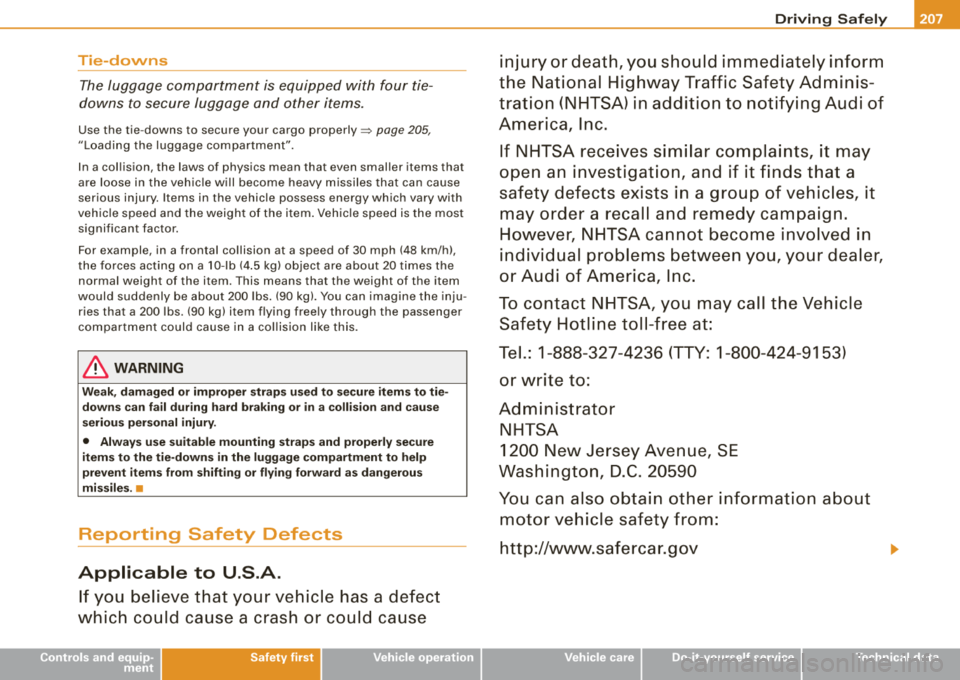
______________________________________________ D_ r_ iv_ in-' g=- S_ a_ fe-"ly __ ffllll
Tie-downs
The luggage compartment is equipped with four tie
downs to secure luggage and other items.
Use the tie -downs to secure your cargo properly => page 205,
"Loading the luggage compartment".
In a collision, the laws of physics mean that even smaller items that
are loose in the vehicle will become heavy missiles that can cause
serious injury. Items in the vehicle possess energy which vary with
vehicle speed and the weight of the item. Vehicle speed is the most
significant factor.
For example, in a frontal collision at a speed of 30 mph (48 km/h),
the forces acting on a 10-lb (4.5 kg) object are about 20 times the
normal weight of the item. This means that the weight of the item
would suddenly be about 200 lbs. (90 kg). You can imagine the inju ries that a 200 lbs. (90 kg) item flying freely through the passenger
compartment could cause in a collision like this.
& WARNING
Weak, damaged or improper straps used to secure items to tie
downs can fail during hard braking or in a collision and cause
serious personal injury.
• Always use suitable mounting straps and properly secure
items to the tie-downs in the luggage compartment to help
prevent items from shifting or flying forward as dangerous
missiles. •
Reporting Safety Defects
Applicable to U.S.A.
If you believe that your vehicle has a defect
which could cause a crash or could cause
Controls and equip
ment Safety first Vehicle operation
injury or death, you
should immediately inform
the National Highway Traffic Safety Adminis
tration (NHTSA) in addition to notifying Audi of
America, Inc.
If NHTSA receives similar complaints, it may
open an investigation, and if it finds that a
safety defects exists in a group of vehicles, it
may order a recall and remedy campaign.
However, NHTSA cannot become involved in
individual problems between you, your dealer,
or Audi of America, Inc.
To contact NHTSA, you may call the Vehicle
Safety Hotline toll-free at:
Tel.: 1-888-327-4236 (TTY: 1-800-424-9153) or write to:
Administrator NHTSA
1200 New Jersey Avenue, SE
Washington, D.C. 20590
You can also obtain other information about
motor vehicle safety from:
http://www.safercar.gov
Vehicle care Do-it-yourself service Technical data
Page 211 of 404
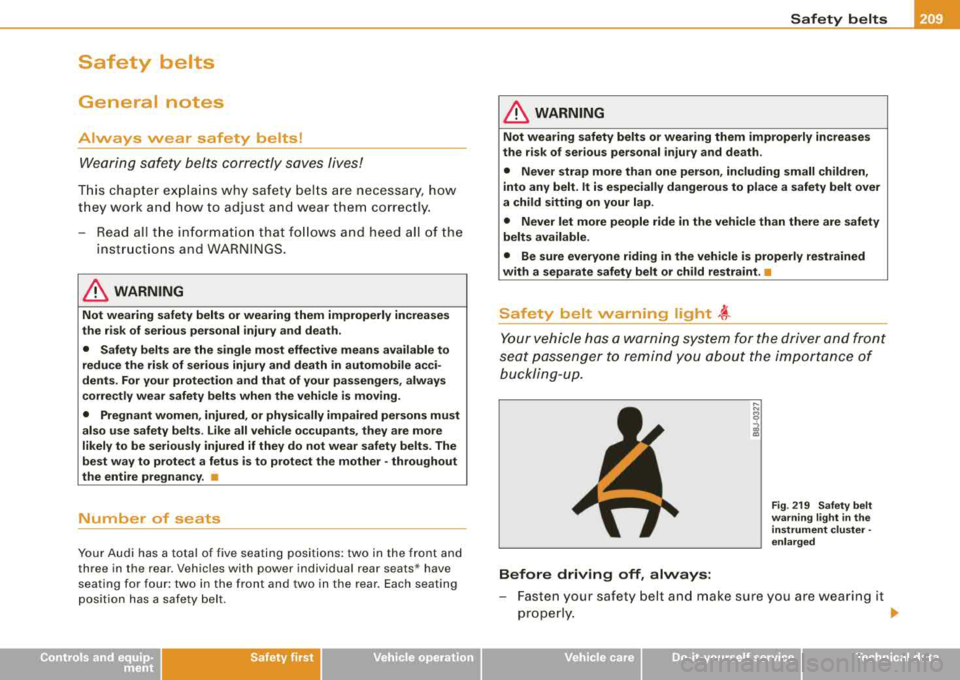
_________________________________________________ s_ a_f _e _t .:,.y _ b_ e_lt_ s __ lfll
Safety belts
General notes
Always wear safety belts!
Wearing safety belts correctly saves lives!
This chapter explains why safety belts are necessary, how
they work and how to adjust and wear them correctly.
- Read all the information that follows and heed all of the
instructions and WARNINGS.
& WARNING
Not wearing safety belts or wearing them improperly increases
the risk of serious personal injury and death.
• Safety belts are the single most effective means available to
reduce the risk of serious injury and death in automobile acci
dents. For your protection and that of your passengers, always
correctly wear safety belts when the vehicle is moving.
• Pregnant women, injured, or physically impaired persons must
also use safety belts . Like all vehicle occupants, they are more
likely to be seriously injured if they do not wear safety belts. The
best way to protect a fetus is to protect the mother -throughout
the entire pregnancy. •
Number of seats
Your Audi has a total of five seating positions: two in the front and
three in the rear. Vehicles with power individual rear seats* have
seating for four: two in the front and two in the rear. Each seating
position has a safety belt.
Controls and equip ment Safety first
Vehicle operation
& WARNING
Not wearing safety belts or wearing them improperly increases
the risk of serious personal injury and death .
• Never strap more than one person, including small children,
into any belt. It is especially dangerous to place a safety belt over
a child sitting on your lap.
• Never let more people ride in the vehicle than there are safety
belts available.
• Be sure everyone riding in the vehicle is properly restrained
with a separate safety belt or child restraint. •
Safety belt warning light ~
Your vehicle has a warning system for the driver and front
seat passenger to remind you about the importance of
buckling-up.
Before driving off, always:
Fig . 219 Safety belt
warning light in the
instrument cluster -
enlarged
- Fasten your safety belt and make sure you are wearing it
properly.
.,_
Vehicle care Do-it-yourself service Technical data
Page 213 of 404
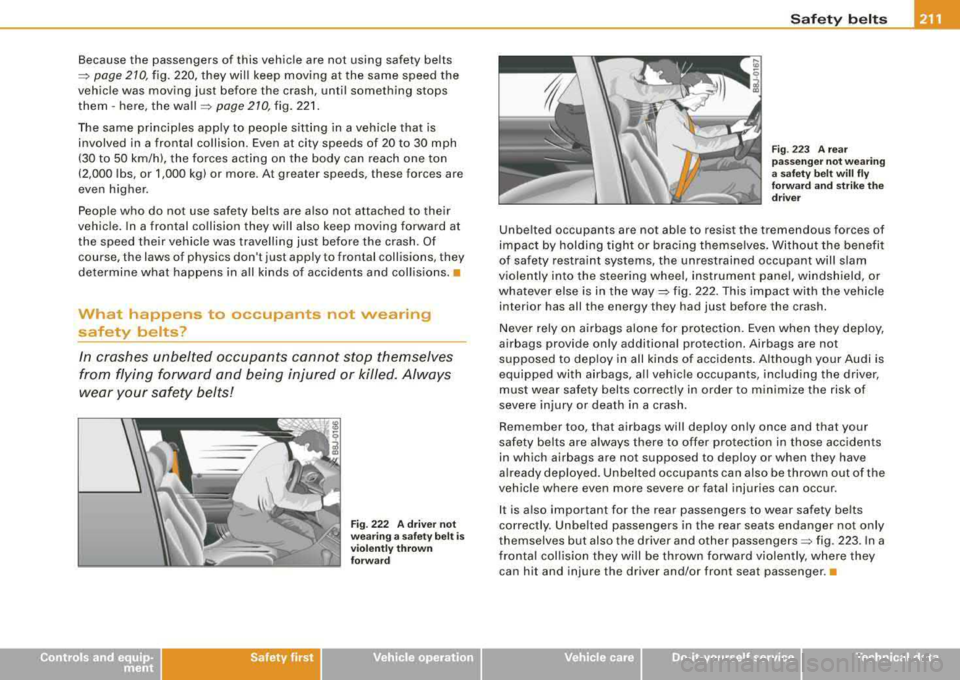
Because the passengers of this vehicle are not using safety belts
=> page 210, fig. 220, they will keep moving at the same speed the
vehicle was moving just before the crash, un til some thing stops
them
-here, the wall ~ page 210, fig. 221.
The same principles apply to people sitting in a vehicle that is involved in a frontal collision. Even at city speeds of 20 to 30 mph
(30 to 50 km/h), the forces acting on the body can reach one ton
(2,000 lbs, or 1,000 kg) or more . A t grea ter spe eds, these forc es are
even higher.
People who do not use safety bel ts are also no t attached to their
vehicle. In a frontal collision they will also keep moving forward at
the speed their vehicle was travelling just before the crash. Of course, the laws of physics don't just apply to frontal collisions, they
determine what happens in all kinds of accidents and collisions. •
What happens to occupants not wearing
safety belts?
In crashes unbelted occupants cannot stop themselves
from flying forward and being injured or killed. Always
wear your safety belts!
Fig . 222 A driver not
wearing a safety belt is
violently thrown
forward
Safety belts
Fig . 223 A rear
passenger not wearing
a safety belt will fly
forward and strike the
driver
Unbelted occupants are no t able to resist the tremendous forces of
impact by holding tight or bracing themselves. Without the benefit
of safety restraint systems, the unrestrained occupant will slam
violently into the steering wheel, instrument panel, windshield, or
whatever else is in the
way~ fig. 222 . This impact with the vehicle
interior has all th e energy th ey had just before the crash.
Never rely on airbags alone for protection. Even when they deploy,
airbags provide only additional protection. Airbags are not
supposed to deploy in all kinds of accidents. Although your Audi is
equipped with airbags , all vehicle occupants, including the driver,
must wear safety belts correctly in order to minimize the risk of
severe injury or death in a crash .
Remember too , that airbags will deploy only once and that your
safety belts are always there to offer protection in those accidents
in which airbags are not suppos ed to deploy or wh en they have
already deployed. Unbelted occupants can also be thrown out of the
vehicle where even more severe or fatal injuries can occur .
It is also important for the rear passengers to wear safety belts
correctly . Unbelted passengers in the rear seats endanger not only
themselves but also the dr iver and other
passengers => fig. 223. In a
frontal collision they will be thrown forward violently, where they can hit and injure the driver and/or front seat passenger. •
Vehicle care I I Technical data
Page 219 of 404
![AUDI S8 2008 User Guide Safety b elts -
----------------=--
[ i ] Tip s
The sa fet y belt pretens ioner can on ly be activated once.
• I n minor frontal and side col lisions, in rear -end collisions, in AUDI S8 2008 User Guide Safety b elts -
----------------=--
[ i ] Tip s
The sa fet y belt pretens ioner can on ly be activated once.
• I n minor frontal and side col lisions, in rear -end collisions, in](/img/6/57619/w960_57619-218.png)
Safety b elts -
----------------=--
[ i ] Tip s
The sa fet y belt pretens ioner can on ly be activated once.
• I n minor frontal and side col lisions, in rear -end collisions, in a
rollover and in accidents involving very litt le impact force, the safety
belt pretensioner are not activated .
• When the safety be lt pretensioner is activated, a fine dust is
released . This is normal and is not caused by a fire i n the vehicle.
• T he relevant safety requirements must be observed when the
vehic le or c om po n en ts of the system are scrapped . A qua lifi ed deal
ership is fami liar with these regulations and wil l be p leased to pass
on the info rmation to you .
• Be sure to observe al l safety, environmenta l and other regula
t ions if the veh ic le or indiv idual parts of the sys tem, particu larly the
safety belt or airbag, are to be disposed. We recommend you have
your au thorized A udi dea ler perform this service for you .•
Service and disposal of safety belt
pretension er
The safety belt pretens io ners are parts of the sa fety be lts on your
Audi. Installing, removing, servicing or repairing of belt preten
s ioners can damage the sa fe ty be lt system and prevent it from
working correctly in a collision.
There a re some important things yo u have to know to make su re
t hat t he effec tive ness o f the system w ill not be impaired and that
discarded compone nts do not cause injury or po llute the environ
ment.
& WARNING
Improper care , servicing and repair pro cedures can increase the
ri sk of personal injury and death by preventing a safety belt
pretension er from activating when needed or activating it unex
pectedly:
Controls and equip ment Safety first
Vehicle operation
&, WARNING (continued )
• The belt pretensioner system can be a ctivated only once. If belt
preten sioner s ha ve been activated, the system mu st be repla ced .
• Never repair , adju st, or change any part s of the safety belt
s ystem .
• Safety belt sy stems including safety belt pretensioners cannot
be repaired. Speci al pro cedures are required for removal , in stalla
tion and di sposal of this system .
• For any work on the safety belt system , we strongly re com
mend that you see your authorized Audi dealer or qualified techni
c ian who ha s an Audi approved repair m anual , training and spe cial
equipment nece ssary .
~ For the sake of the environment
Undeployed airbag modu les and pretensioners might be c lassif ied
as Perchlorate Material -special handling may apply, see
www .dtsc.ca .gov/hazardouswaste/perchlorate . When the vehicle or
parts of the restraint system including airbag modules safety be lts
with pretensioners are scrapped, a ll applicable laws and regu la
tions must be observed . Your authorized Au di dealer is fa mi liar with
these requirements and we recommend that you have your dea ler
perfor m this service for y ou.•
Vehicle care Do-it-yourself service Technical data
Page 221 of 404
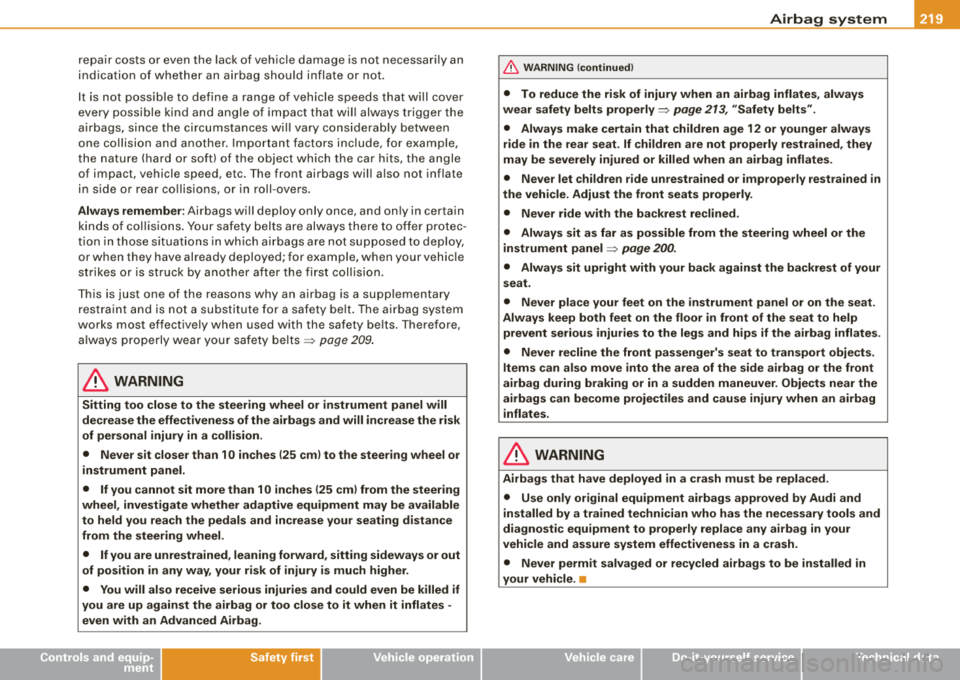
__________________________________________________ A_ i_ r _b _a-' g=- s_ y=- s_t _e _m __ lfflll
r ep air costs or ev e n the lac k of veh icle dama ge is not necessari ly an
indicati on of w heth e r an air b ag s houl d infla te or not .
I t is not poss ib le to def in e a ran ge of v ehicle sp ee ds t hat w il l cover
eve ry po ssible kind and ang le of impact that wil l a lway s trigger the
a ir b ags , s in ce t he cir cum stanc es w ill vary c onsid era bly be tw een
one co llision and another . Important factors inc lude , for example,
th e nat ure ( hard or soft) of the o bject w hic h the car h its, the a ng le
of impact, ve hicle speed, etc. The front airbags wi ll also not inflate
in side or rea r co lli s io ns, or i n ro ll-ov ers .
Always remember : Airbags w ill d eploy only onc e, an d on ly in c ertain
k inds of coll isi ons. Your s afe ty b elt s a re a lway s the re to o ffer prot ec
t ion in th ose s ituat io ns in whi ch airba gs are not su pposed to deplo y,
or whe n th ey hav e a lready dep lo yed; for ex am ple, wh en your v ehi cle
s tr ik es or i s struc k by another a ft e r th e fir st c ollis ion .
T his is just one of the reasons why a n airbag is a su pple mentary
r es traint and is not a sub stitut e for a sa fe ty b elt. T he ai rbag s ystem
w ork s most eff ect ively wh en us ed w ith the saf ety be lts . T herefore,
alw ay s pr operly w ea r y ou r safe ty b e lts ~ page 2 09.
& WARNING
Sitting too close to the steering wheel or instrument panel will
decrease the effectiveness of the airbags and will increase the risk
of personal injury in a collision.
• Never sit closer than 10 inches (25 cm) to the steering wheel or
instrument panel.
• If you cannot sit more than 10 inches (25 cm ) from the steering
wheel , investigate whether adaptive equipment may be available
to held you reach the pedals and increase your seating distance
from the steering wheel.
• If you are unrestrained , leaning forward, sitting sideways or out
of position in any way, your risk of injury is much higher .
• You will also receive serious injuries and could even be killed if
you are up against the airbag or too close to it when it inflates -
even with an Advanced Airbag.
Controls and equip ment Safety first
Vehicle operation
&, WARNING (continued )
• To reduce the risk of injury when an airbag inflates, always
wear safety belts
properly ~ page 213, "Safety belts ".
• Always make certain that children age 12 or younger always
ride in the rear seat . If children are not properly restrained , they
may be severely injured or killed when an airbag inflates.
• Never let children ride unrestrained or improperly restrained in
the vehicle . Adjust the front seats properly .
• Never ride with the backrest reclined .
• Always sit as far as possible from the steering wheel or the
instrument panel
~ page 200.
• Always sit upright with your back against the backrest of your
seat.
• Never place your feet on the instrument panel or on the seat .
Always keep both feet on the floor in front of the seat to help prevent serious injuries to the legs and hips if the airbag inflates .
• Never recline the front passenger's seat to transport objects.
Items can also move into the area of the side airbag or the front
airbag during braking or in a sudden maneuver. Objects near the
airbags can become projectiles and cause injury when an airbag
inflates .
& WARNING
Airbags that have deployed in a crash must be replaced.
• Use only original equipment airbags approved by Audi and
installed by a trained technician who has the necessary tools and
diagnostic equipment to properly repla ce any airbag in your
vehicle and assure system effectiveness in a crash .
• Never permit salvaged or recy cled airbags to be installed in
your vehicle. •
Vehicle care Do-it-yourself service Technical data
Page 223 of 404
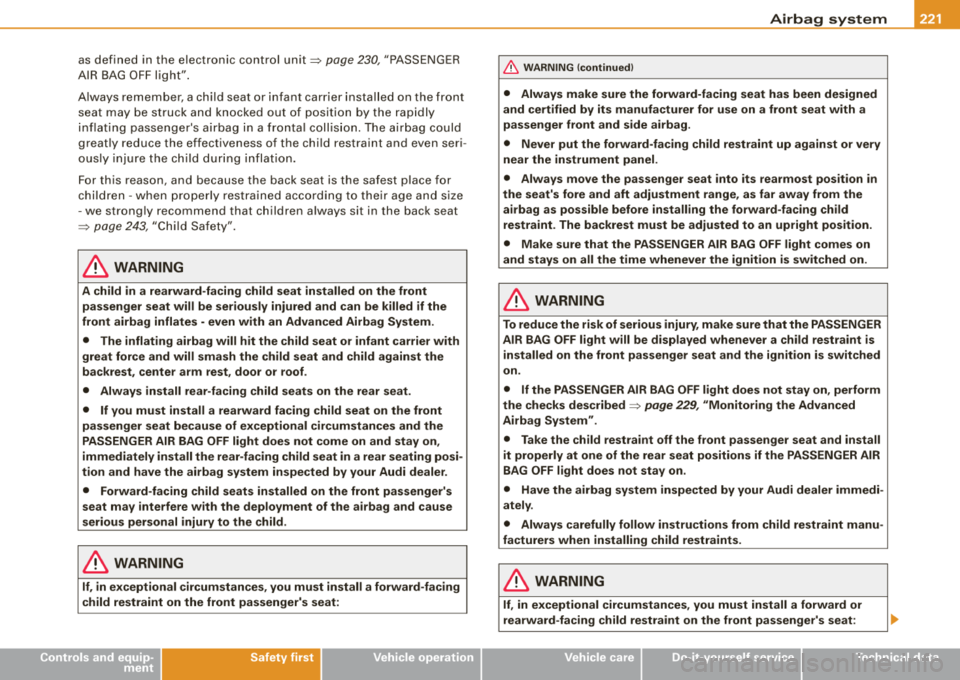
as defined in the elec tronic control unit~ page 230 , "PA SSENGER
AI R BAG OFF ligh t".
A lways r em ember, a ch ild seat or infant carrier install ed on th e front
seat may be st ruck and knocked out of position by the rap idly
i n fl ating pass enger's airbag in a fr ontal co llisio n. T he airb ag co uld
greatly reduce the effectivenes s of the chi ld restraint and even seri
ously inju re t he c hild duri ng i nflatio n .
F or this reason, and because the bac k seat is the safest place for
chi ldr en -w hen pro perly res traine d acc ording to th eir age an d size
- w e stron gly recomm end that c hildren a lways sit in th e bac k seat
~ page 243, "C hil d Safe ty" .
& WARNING
A child in a rearward -facing child seat installed on the front
passenger seat will be seriously injured and can be killed if the
front airbag inflates - even with an Advanced Airbag System.
• The inflating airbag will hit the child seat or infant car rier with
great force and will smash the child seat and child against the
backrest , center arm rest, door or roof .
• Always install rear-facing child seats on the rear seat.
• If you must install a rearward facing child seat on the front
passenger seat because of exceptional circumstances and the
PASSENGER AIR BAG OFF light does not come on and stay on,
immediately install the rear-facing child seat in a rear seating posi
tion and have the airbag system inspected by your Audi dealer.
• Forward -facing child seats installed on the front passenger's
seat may interfere with the deployment of the airbag and cause
serious personal injury to the child .
& WARNING
If, in exceptional circumstances, you must install a forward-facing
child restraint on the front passenger's seat:
Controls and equip ment Safety first
Vehicle operation
Airbag system
&, WARNING (continued )
• Always make sure the forward-facing seat has been designed
and certified by its manufacturer for use on a front seat with a
passenger front and side airbag .
• Never put the forward-facing child restraint up against or very
near the instrument panel .
• Always move the passenger seat into its rearmost position in
the seat's fore and aft adjustment range, as far away from the
airbag as possible before installing the forward-facing child
restraint. The backrest must be adjusted to an upright position .
• Make sure that the PASSENGER AIR BAG OFF light comes on
and stays on all the time whenever the ignition is switched on.
& WARNING
To reduce the risk of serious injury, make sure that the PASSENGER
AIR BAG OFF light will be displayed whenever a child restraint is
installed on the front passenger seat and the ignition is switched
on.
• If the PASSENGER AIR BAG OFF light does not stay on , perform
the checks described
~ page 229 , "Monitoring the Advanced
Airbag System" .
• Take the child restraint off the front passenger seat and install
it properly at one of the rear seat positions if the PASSENGER AIR
BAG OFF light does not stay on .
• Have the airbag system inspected by your Audi dealer immedi
ately .
• Always carefully follow instructions from child restraint manu
facturers when installing child restraints .
& WARNING
If, in exceptional circumstances, you must install a forward or
rearward -facing child restraint on the front passenger's seat:
Vehicle care Do-it-yourself service Technical data
Page 225 of 404
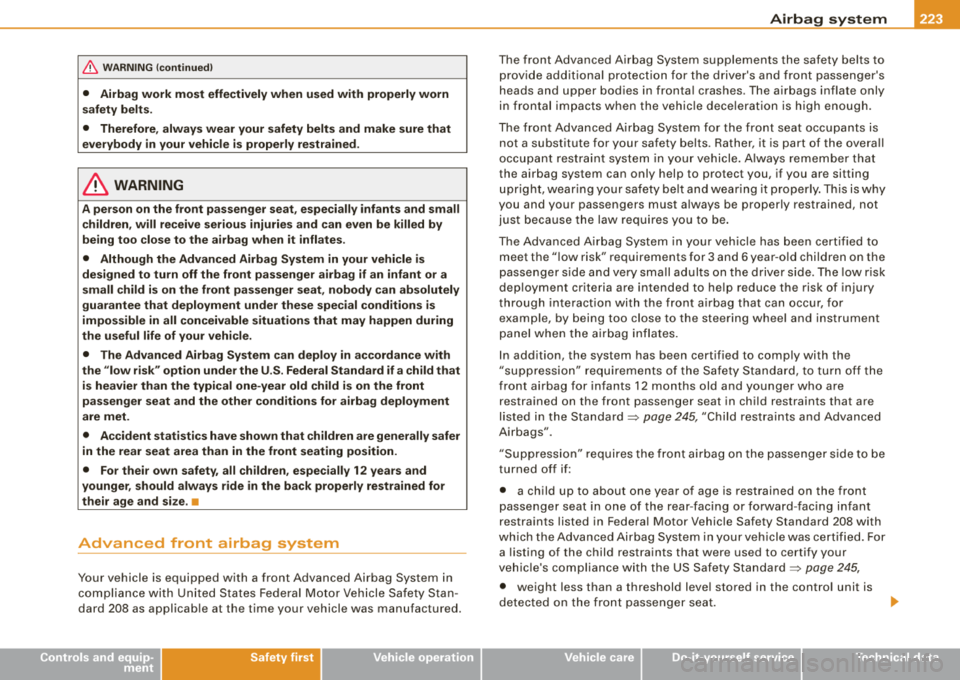
Airbag system -
--------------=---=--
& WARNING (continued)
• Airbag work most effectively when used with properly worn
safety belts.
• Therefore, always wear your safety belts and make sure that
everybody in your vehicle is properly restrained.
& WARNING
A person on the front passenger seat, especially infants and small
children, will receive serious injuries and can even be killed by
being too close to the airbag when it inflates.
• Although the Advanced Airbag System in your vehicle is
designed to turn off the front passenger airbag if an infant or a
small child is on the front passenger seat, nobody can absolutely
guarantee that deployment under these special conditions is
impossible in all conceivable situations that may happen during
the useful life of your vehicle.
• The Advanced Airbag System can deploy in accordance with
the
"low risk" option under the U.S. Federal Standard if a child that
is heavier than the typical one-year old child is on the front
passenger seat and the other conditions for airbag deployment
are met.
• Accident statistics have shown that children are generally safer
in the rear seat area than in the front seating position.
• For their own safety, all children, especially 12 years and
younger, should always ride in the back properly restrained for
their age and size. •
Advanced front airbag system
Your vehicle is equipped with a front Advanced Airbag System in
compliance with United States Federal Motor Vehicle Safety Stan
dard 208 as applicable at the time your vehicle was manufactured.
Controls and equip ment Safety first Vehicle operation
The
front Advanced Airbag System supplements the safety belts to
provide additional protection for the driver's and front passenger's
heads and upper bodies in frontal crashes . The airbags inflate only
in frontal impacts when the vehicle deceleration is high enough.
The front Advanced Airbag System for the front seat occupants is
not a substitute for your safety belts . Rather, it is part of the overall
occupant restraint system in your vehicle. Always remember that
the airbag system can only help to protect you, if you are sitting
upright, wearing your safety belt and wearing it properly. This is why
you and your passengers must always be properly restrained, not
just because the law requires you to be.
The Advanced Airbag System in your vehicle has been certified to
meet the "low risk" requirements for 3 and 6 year -old children on the
passenger side and very small adults on the driver side. The low risk
deployment criteria are intended to help reduce the risk of injury
through interaction with the front airbag that can occur, for
example, by being too close to the steering wheel and instrument
panel when the airbag inflates.
In addition, the system has been certified to comply with the
"suppression" requirements of the Safety Standard, to turn off the
front airbag for infants 12 months old and younger who are
restrained on the front passenger seat in child restraints that are
listed in the
Standard=> page 245, "Child restraints and Advanced
Airbags".
"Suppression" requires the front airbag on the passenger side to be
turned off if:
• a child up to about one year of age is restrained on the front
passenger seat in one of the rear-facing or forward-facing infant
restraints listed in Federal Motor Vehicle Safety Standard 208 with
which the Advanced Airbag System in your vehicle was certified. For
a listing of the child restraints that were used to certify your
vehicle's compliance with the US Safety
Standard => page 245,
• weight less than a threshold level stored in the control unit is
detected on the front passenger seat.
~
Vehicle care Do-it-yourself service Technical data